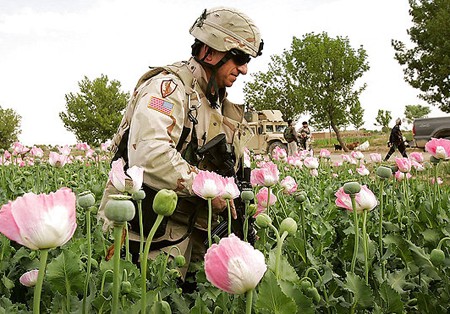American Free Press, November 25, 2014
Afghanistan Opium and ‘Black Ops’
In fact, opium remains Afghanistan’s biggest cash crop, and poppy-derived products brought 3 billion USD to Afghanistan in 2013, constituting 15% of its gross domestic product
By Pete Papaherakles
The United States has been gradually withdrawing troops from Afghanistan since 2011. According to President Barack Hussein Obama, only 9,800 “peacekeeping” troops will remain by the end of December, and all the troops are supposed to be gone by the end of 2016, ending the longest war in American history. But what exactly are we still doing in Afghanistan after 13 years and why did we really go there in the first place?
The stated reason for invading Afghanistan in 2001 was to capture Osama bin Laden, who allegedly led al Qaeda—the terrorist group that supposedly carried out the September 11 attacks—from a cave in Afghanistan.
But after a long, drawn-out war. former Central Intelligence Agency (CIA) Director Leon Panetta said in June 2010 that there were fewer than 100 members of al Qaeda left in Afghanistan. Then, on May 2, 2011, we were told that SEAL Team Six finally found and killed bin Laden in Pakistan and his body was dumped into the sea a couple of days later. At this point “our” stated mission was over.
Yet three and a half years later, U.S. soldiers are still killing and getting killed in Afghanistan.
Opium (and its refined products) is a $65 billion-a-year business, and $55 billion of that comes from the smuggling of heroin. Afghanistan alone accounts for 90% of the world’s annual opium production.
When Obama was elected to office in 2008, there were only 34,000 troops in Afghanistan. When “we” supposedly killed bin Laden in 2011, that number had increased to over 100,000. Until a year ago, there were still 68,000 troops there. Why were they still there? After all, it costs U.S. taxpayers $10 billion a month to remain in that mountainous country.
Further muddying the issue is the fact that today there are even more private contractors in Afghanistan than there are soldiers. In 2013, while there were 68,000 American troops stationed there, there were also 108,000 private contractors in the country. That amounts to 1.6 mercenaries for every American soldier.
At this point, it has become pretty clear that September 11 and bin Laden were just the excuse that Washington needed to invade Afghanistan.
War is big business, and the weapons industry, along with the banking industry, has reaped trillions of dollars from Afghanistan. According to Harvard’s prestigious Kennedy School of Government, the wars in Afghanistan and Iraq will end up costing $6 trillion, or $75,000 for each American household—a huge sum that only serves to enrich bomb-makers and bankers.
Besides the trillions of dollars made by the war and finance industries, a second major reason for attacking Afghanistan was to control the energy resources from the Caspian Sea area and prevent Iran and Russia from building pipelines to Pakistan and India. But that’s not all.
A third motive for the war, which is often overlooked, was to seize control of the highly lucrative opium poppy production in Afghanistan.
Proceeds from illegal drug trafficking have always been a great source for funding illegal black-ops projects by the CIA and other intelligence services. Control of the Golden Triangle’s opium was a major reason behind the Vietnam War. The Iran-Contra scandal was about cocaine, and it is well documented by Gary Webb, Barry Seal and others that the CIA has been the main cocaine trafficker into the United States.

RAWA: Since 2001 the opium cultivation increased over 4,400%. Under the US/NATO, Afghanistan became world largest opium producer, which produces 93% of world opium.
Opium (and its refined products) is a $65 billion-a-year business, and $55 billion of that comes from the smuggling of heroin. Afghanistan alone accounts for 90% of the world’s annual opium production.
While Afghanistan has long been a major producer of opium, the Taliban in 2001 eradicated three-quarters of the world’s crop of opium poppies in one season. In that year, production plummeted from 3,300 metric tons to 200 metric tons.
In 2002, however, the year after the U.S invasion, poppy production shot up to 3,400 tons. By 2007, production had skyrocketed to an all-time high of 7,400 tons. In 2014, annual cultivation reached 225,000 hectares, the highest level in Afghanistan’s history, according to published reports.
As a result, heroin use around the world has also surged. Use of heroin in the U.S. has increased by 80% in recent years.
But the U.S. government still maintains that it is “fighting a war on drugs.” According to John F. Sopko, the U.S. special inspector general for Afghanistan reconstruction, the U.S. has made a “mammoth investment” to stop the opium and heroin trade. On January 15, Sopko said in a testimony before the Senate Caucus on International Narcotics Control, that the U.S. has spent $10 billion since 2002 to combat Afghan poppy production and to induce farmers to plant alternative crops.
But Sopko was also quick to point out that American efforts to quell poppy production in Afghanistan have been a massive failure. In fact, opium remains Afghanistan’s biggest cash crop, and poppy-derived products brought $3 billion to Afghanistan in 2013, constituting 15% of its gross domestic product.
Pete Papaherakles is a writer and political cartoonist for AFP and is also AFP’s outreach director.
Originally published on Nov. 23, 2014
Characters Count: 6764
